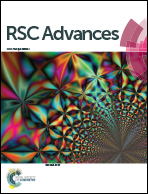Formation of silicon quantum dots by RF power driven defect control
Abstract
We studied the structural and optical properties of silicon nitride (SiNx) films synthesized by changing the applied radio frequency (RF) power in plasma-enhanced chemical vapor deposition. By decreasing the RF power from 100 W to 40 W, the photoluminescence (PL) of SiNx becomes stronger and the central PL peak position shifts from 2.41 eV to 1.78 eV. The size of the silicon grains becomes bigger as the applied RF power decreases, and eventually nano-sized amorphous Si quantum dots (nsa-Si QDs) are formed in the sample fabricated using 40 W RF power. By analyzing the chemical states of the Si 2p X-ray photoelectron spectroscopy core-level spectra, we found that the formation of nsa-Si QDs is considerably enhanced due to the disappearance of N3![[triple bond, length as m-dash]](https://www.rsc.org/images/entities/char_e002.gif) Si–Si
Si–Si![[triple bond, length as m-dash]](https://www.rsc.org/images/entities/char_e002.gif) N3 defects when the applied RF power reaches a certain point between 60 W and 40 W. From these results, we conclude that the type and the number of defects in SiNx play crucial roles in the initial formation of nsa-Si QDs in SiNx. In addition, this investigation paves the way for controlling the formation of quantum structures from defects to nsa-Si QDs simply by tuning the RF power. We expect that this work will contribute to the realization of Si-based full-color LEDs or tandem solar cells in the near future.
N3 defects when the applied RF power reaches a certain point between 60 W and 40 W. From these results, we conclude that the type and the number of defects in SiNx play crucial roles in the initial formation of nsa-Si QDs in SiNx. In addition, this investigation paves the way for controlling the formation of quantum structures from defects to nsa-Si QDs simply by tuning the RF power. We expect that this work will contribute to the realization of Si-based full-color LEDs or tandem solar cells in the near future.


 Please wait while we load your content...
Please wait while we load your content...